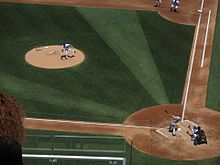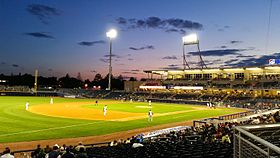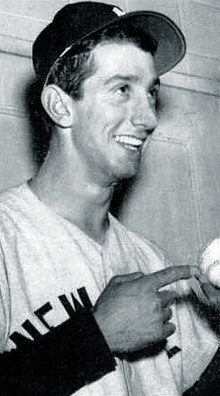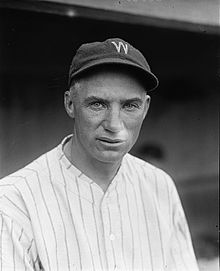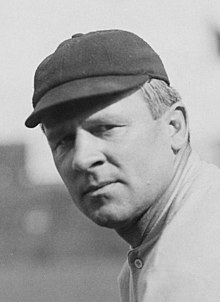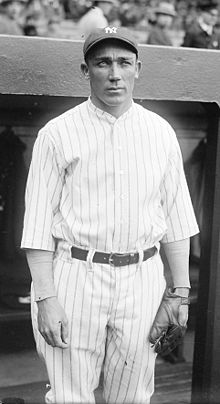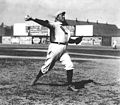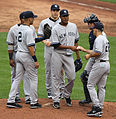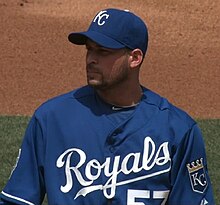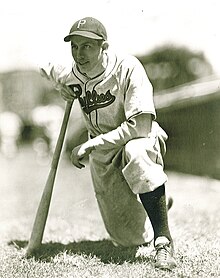Portal:Baseball
Portal maintenance status: (June 2018)
|
| Main page | Content, Categories & Topics | WikiProjects & Things you can do |
The Baseball Portal
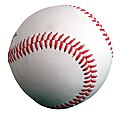
Baseball is a bat-and-ball sport played between two teams of nine players each, taking turns batting and fielding. The game occurs over the course of several plays, with each play generally beginning when a player on the fielding team, called the pitcher, throws a ball that a player on the batting team, called the batter, tries to hit with a bat. The objective of the offensive team (batting team) is to hit the ball into the field of play, away from the other team's players, allowing its players to run the bases, having them advance counter-clockwise around four bases to score what are called "runs". The objective of the defensive team (referred to as the fielding team) is to prevent batters from becoming runners, and to prevent runners advancing around the bases. A run is scored when a runner legally advances around the bases in order and touches home plate (the place where the player started as a batter).
The opposing teams switch back and forth between batting and fielding; the batting team's turn to bat is over once the fielding team records three outs. One turn batting for each team constitutes an inning. A game is usually composed of nine innings, and the team with the greater number of runs at the end of the game wins. Most games end after the ninth inning, but if scores are tied at that point, extra innings are usually played. Baseball has no game clock, though some competitions feature pace-of-play regulations such as the pitch clock to shorten game time.
Baseball evolved from older bat-and-ball games already being played in England by the mid-18th century. This game was brought by immigrants to North America, where the modern version developed. Baseball's American origins, as well as its reputation as a source of escapism during troubled points in American history such as the American Civil War and the Great Depression, have led the sport to receive the moniker of "America's Pastime"; since the late 19th century, it has been unofficially recognized as the national sport of the United States, though in modern times is considered less popular than other sports, such as American football. In addition to North America, baseball spread throughout the rest of the Americas and the Asia–Pacific in the 19th and 20th centuries, and is now considered the most popular sport in parts of Central and South America, the Caribbean, and East Asia, particularly in Japan, South Korea, and Taiwan. (Full article...)
 Featured articles - load new batch
Featured articles - load new batch
-
Image 1
Daniel Lucius "Doc" Adams (November 1, 1814 – January 3, 1899) was an American baseball player and executive who is regarded by historians as an important figure in the sport's early years. For most of his career he was a member of the New York Knickerbockers. He first played for the New York Base Ball Club in 1840 and started his Knickerbockers career five years later, continuing to play for the club into his forties and to take part in inter-squad practice games and matches against opposing teams. Researchers have called Adams the creator of the shortstop position, which he used to field short throws from outfielders. In addition to his playing career, Adams manufactured baseballs and oversaw bat production; he also occasionally acted as an umpire.
From 1847 to 1861, the Knickerbockers selected Adams as their president six times, and as a vice president, treasurer, or director in six other years. As president of the club, Adams was an advocate of rule changes in baseball that resulted in nine-man teams and nine-inning games. When the National Association of Base Ball Players (NABBP) was formed in 1858, he led the rules and regulations committee of the new organization. In his role, Adams ruled that the fields' bases should be 90 feet (27 m) apart, the modern distance, and supported the elimination of the "bound rule", which allowed for balls caught after one bounce to be recorded as outs. He resigned from his positions with the Knickerbockers and NABBP in 1862. Adams' contributions in creating baseball's rules went largely unrecognized for decades after his 1899 death, but in 1980 a letter about him appeared in The New York Times; by 1993, researcher John Thorn had written about Adams' role. Other historians have given him credit for helping to develop the sport, and Thorn has called Adams "first among the Fathers of Baseball". (Full article...) -
Image 2

Hershiser pitching for the Dodgers in 1993
During the 1988 Major League Baseball season, pitcher Orel Hershiser of the Los Angeles Dodgers set the MLB record for consecutive scoreless innings pitched. Over 59 consecutive innings, opposing hitters did not score a run against Hershiser. During the streak, he averted numerous high-risk scoring situations. The streak spanned from the sixth inning of an August 30 game against the Montreal Expos to the 10th inning of a September 28 game against the San Diego Padres. The previous record of 58+2⁄3 innings was set by former Dodger pitcher Don Drysdale in 1968; as the team's radio announcer, Drysdale called Hershiser's streak as he pursued the new record. Pundits have described the streak as among the greatest records in baseball history, with one pundit ranking it among the greatest individual feats in American sports.
During the streak, the Elias Sports Bureau changed its criteria for the official consecutive scoreless innings record for starting pitchers from including fractional innings in which one or two outs had been recorded to counting only complete scoreless innings. Since the streak was active at the end of the 1988 season, it could have spanned two separate seasons. However, Hershiser yielded a run in his first inning of work in the 1989 season against the Cincinnati Reds, thus ending the streak at 59 consecutive scoreless innings pitched. The streak includes only innings pitched in the regular season, excluding eight scoreless innings Hershiser pitched to start Game 1 of the 1988 National League Championship Series on October 4 (unofficially extending his streak to 67 combined innings). Although he completed the ninth inning in each start, the streak's final game lasted 16 innings, of which he pitched only the first 10. Thus, Hershiser did not match Drysdale's record of six consecutive complete game shutouts. Like Drysdale's streak, the penultimate game of Hershiser's streak was a Dodgers–Giants game that featured a controversial umpire's ruling that saved the streak. (Full article...) -
Image 3
First Horizon Park, formerly known as First Tennessee Park, is a baseball park in downtown Nashville, Tennessee, United States. The home of the Triple-A Nashville Sounds of the International League, it opened on April 17, 2015, and can seat up to 10,000 people. It replaced the Sounds' former home, Herschel Greer Stadium, where the team played from its founding in 1978 through 2014.
The park was built on the site of the former Sulphur Dell, a minor league ballpark in use from 1885 to 1963. It is located between Third and Fifth Avenues on the east and west (home plate, the pitcher's mound, and second base are directly in line with Fourth Avenue to the stadium's north and south) and between Junior Gilliam Way and Harrison Street on the north and south. The Nashville skyline can be seen from the stadium to the south. (Full article...) -
Image 4
Kenesaw Mountain Landis (/ˈkɛnɪsɔː ˈmaʊntɪn ˈlændɪs/; November 20, 1866 – November 25, 1944) was an American jurist who served as a United States federal judge from 1905 to 1922 and the first commissioner of baseball from 1920 until his death. He is remembered for his resolution of the Black Sox Scandal, in which he expelled eight members of the Chicago White Sox from organized baseball for conspiring to lose the 1919 World Series and repeatedly refused their reinstatement requests. His iron rule over baseball in the near quarter-century of his commissionership is generally credited with restoring public confidence in the game.
Landis was born in Millville, Ohio. Raised in Indiana, he became a lawyer, and then personal secretary to Walter Q. Gresham, the new United States Secretary of State, in 1893. He returned to private practice after Gresham died in office. (Full article...) -
Image 5
Alfred Manuel "Billy" Martin Jr. (May 16, 1928 – December 25, 1989) was an American Major League Baseball second baseman and manager who, in addition to leading other teams, was five times the manager of the New York Yankees. First known as a scrappy infielder who made considerable contributions to the championship Yankee teams of the 1950s, he then built a reputation as a manager who would initially make bad teams good, before ultimately being fired amid dysfunction. In each of his stints with the Yankees he managed them to winning records before being fired by team owner George Steinbrenner or resigning under fire, usually amid a well-publicized scandal such as Martin's involvement in an alcohol-fueled fight.
Martin was born in a working-class section of Berkeley, California. His skill as a baseball player gave him a route out of his home town. Signed by the Pacific Coast League Oakland Oaks, Martin learned much from Casey Stengel, the man who would manage him both in Oakland and in New York, and enjoyed a close relationship with Stengel. Martin's spectacular catch of a wind-blown Jackie Robinson popup late in Game Seven of the 1952 World Series saved that series for the Yankees, and he was the hitting star of the 1953 World Series, earning the Most Valuable Player award in the Yankee victory. He missed most of two seasons, 1954 and 1955, after being drafted into the Army, and his abilities never fully returned; the Yankees traded him after a brawl at the Copacabana club in New York during the 1957 season. Martin bitterly resented being traded, and did not speak to Stengel for years, a time during which Martin completed his playing career with various teams. (Full article...) -
Image 6
A picture of a Wii Sports disc
Wii Sports is a 2006 sports simulation video game developed and published by Nintendo for the Wii video game console. The game was released in North America along with the Wii on November 19, 2006, and in Japan, Australia, and Europe the following month. It was included as a pack-in game with the console in all territories except Japan, making it the first sports game included with the launch of a Nintendo system since Mario's Tennis for the Virtual Boy in 1995. The game was later released on its own as part of the Nintendo Selects collection of games.
Wii Sports is a collection of five sports simulations designed to demonstrate the motion-sensing capabilities of the Wii Remote. The five sports included are tennis, baseball, bowling, golf, and boxing. Players use the Wii Remote to mimic actions performed in real-life sports, such as swinging a tennis racket or rolling a bowling ball. The rules for each game are simplified to make them more accessible to new players. The game also features training and fitness modes that monitor players' progress in the sports. (Full article...) -
Image 7
Mariano Rivera (born November 29, 1969) is a Panamanian-American former professional baseball pitcher who played 19 seasons in Major League Baseball (MLB) for the New York Yankees, from 1995 to 2013. Nicknamed "Mo" and "Sandman", he spent most of his career as a relief pitcher and served as the Yankees' closer for 17 seasons. A thirteen-time All-Star and five-time World Series champion, he is MLB's career leader in saves (652) and games finished (952). Rivera won five American League (AL) Rolaids Relief Man Awards and three Delivery Man of the Year Awards, and he finished in the top three in voting for the AL Cy Young Award four times. In 2019, he was inducted into the Baseball Hall of Fame in his first year of eligibility, and is to date the only player ever to be elected unanimously by the Baseball Writers' Association of America (BBWAA).
Raised in the modest Panamanian fishing village of Puerto Caimito, Rivera was an amateur player until he was signed by the Yankees organization in 1990. He debuted in the major leagues in 1995 as a starting pitcher, before permanently converting to a relief pitcher late that year. After a breakthrough season in 1996 as a setup man, he became the Yankees' closer in 1997. In the following seasons, he established himself as one of baseball's top relievers, leading the major leagues in saves in 1999, 2001, and 2004. Rivera primarily threw a sharp-moving, mid-90s mile-per-hour cut fastball that frequently broke hitters' bats and earned a reputation as one of the league's toughest pitches to hit. With his presence at the end of games, signaled by his foreboding entrance song "Enter Sandman", Rivera was a key contributor to the Yankees' dynasty in the late 1990s and early 2000s that won four championships in five years. He was an accomplished postseason performer, winning the 1999 World Series Most Valuable Player (MVP) Award and the 2003 AL Championship Series MVP Award, while setting postseason records that included lowest earned run average (ERA) (0.70) and most saves (42). (Full article...) -
Image 8
James Howard Thome (/ˈtoʊmi/; TOH-mee; born August 27, 1970) is an American former professional baseball first baseman, third baseman and designated hitter, who played in Major League Baseball (MLB) for 22 seasons (1991–2012). A prolific power hitter, Thome hit 612 home runs during his career—the eighth-most all time. He amassed a total of 2,328 hits and 1,699 runs batted in (RBIs). His career batting average was .276. He was a member of five All-Star teams and won a Silver Slugger Award in 1996.
Thome grew up in Peoria, Illinois, as part of a large blue-collar family of athletes, who predominantly played baseball and basketball. After attending Illinois Central College, he was drafted by the Indians in the 1989 draft, and made his big league debut in 1991. Early in his career, Thome played third base, before eventually becoming a first baseman. With the Indians, he was part of a core of players that led the franchise to five consecutive playoff appearances in the 1990s, including World Series appearances in 1995 and 1997. Thome spent over a decade with Cleveland, before leaving via free agency after the 2002 season, to join the Philadelphia Phillies, with whom he spent the following three seasons. Traded to the Chicago White Sox before the 2006 season, he won the American League (AL) Comeback Player of the Year Award that year and joined the 500 home run club during his three-season tenure with the White Sox. By this point in his career, back pain limited Thome to being a designated hitter. After stints with the Los Angeles Dodgers and Minnesota Twins, he made brief returns to Cleveland and Philadelphia, before ending his career with the Baltimore Orioles. Upon retiring, Thome accepted an executive position with the White Sox. (Full article...) -
Image 9William Derrick Bates (born December 7, 1963) is an American former professional baseball second baseman and pinch runner who played in Major League Baseball (MLB) for the Milwaukee Brewers and the Cincinnati Reds. In 29 career games, Bates had a batting average of .125 with six hits, two runs batted in (RBI), 11 runs, and eight stolen bases. Though his defensive position was at second base, the Reds primarily used Bates as a pinch runner. After he scored the winning run in Game 2 of the 1990 World Series, Bates never played in MLB again.
Born in Houston, Bates attended the University of Texas and, in his freshman season, won the 1983 College World Series as a part of the Texas Longhorns baseball team. For the next two seasons, Bates was named to the College Baseball All-America Team, a team composed of the best collegiate baseball athletes in America. Drafted by Milwaukee in the fourth round of the 1985 MLB draft, he rose through the Brewers' farm system helping several of his minor league teams win their respective league titles. He made his MLB debut in 1989, after Milwaukee's starting second baseman Jim Gantner was injured. A trade in 1990 sent Bates to Cincinnati, where the Reds used him primarily as a pinch runner at the end of the regular season and into the postseason. Facing the Oakland Athletics in the World Series, Bates reached base on a pinch hit single against Dennis Eckersley and later scored the winning run in Game 2 as the Reds swept the Athletics four games to none. Following the World Series championship, the Reds re-signed Bates on a one-year contract, and he played for their Triple-A team. He spent the next year with the Chicago Cubs Triple-A affiliate, and last played exhibition baseball in 1995. After retiring, he worked as an equipment supplier in the oil and gas industry in Houston. (Full article...) -
Image 10

Ichiro Suzuki was the first high-profile NPB player (second overall) to use the posting system.
The posting system (ポスティングシステム, posutingu shisutemu) is a baseball player transfer system that operates between Nippon Professional Baseball (NPB) and Major League Baseball (MLB). Despite the drafting of the United States – Japanese Player Contract Agreement, unveiled in 1967 to regulate NPB players moving to MLB, problems began to arise in the late 1990s. Some NPB teams lost star players without compensation, an issue highlighted when NPB stars Hideo Nomo and Alfonso Soriano left to play in MLB after using loopholes to void their existing contracts. A further problem was that NPB players had very little negotiating power if their teams decided to deal them to MLB, as when pitcher Hideki Irabu was traded to an MLB team for which he had no desire to play. In 1998, the Agreement was rewritten to address both problems; the result was dubbed the "posting system".
Under this system, when an NPB player is "posted", his NPB team notifies the MLB Commissioner, with the posting fee based on the type of contract a player signs and its value. For minor-league contracts, the fee is a flat 25% of contract's value; for MLB contracts, the fee is based on the value of the contract that the posted player eventually signs. The player is then given 30 days to negotiate with any MLB team willing to pay the NPB team's posting fee. If the player agrees on contract terms with a team before the 30-day period has expired, the NPB team receives the posting fee from the signing MLB team as a transfer fee, and the player is free to play in MLB. If no MLB team comes to a contract agreement with the posted player, then no fee is paid, and the player's rights revert to his NPB team. The current process replaced one in which MLB held a silent auction during which MLB teams submitted sealed, uncapped bids in an attempt to win the exclusive negotiating rights with the posted player for a period of 30 days. Once the highest bidding MLB team was determined, the player could then only negotiate with that team. (Full article...) -
Image 11
Stanley Anthony Coveleski (born Stanislaus Kowalewski, July 13, 1889 – March 20, 1984) was an American right-handed pitcher in Major League Baseball who played for four American League (AL) teams between 1912 and 1928, primarily the Cleveland Indians. The star of the Indians pitching staff, he won over 20 games each year from the war-shortened 1918 season through 1921, leading the AL in shutouts twice and in strikeouts and earned run average (ERA) once each during his nine years with the club. The star of the 1920 World Series, he led the Indians to their first title with three complete-game victories, including a 3–0 shutout in the Game 7 finale. Traded to the Washington Senators after the 1924 season, he helped that club to its second AL pennant in a row with 20 victories against only 5 losses, including a 13-game winning streak, while again leading the league in ERA.
Coveleski followed in the footsteps of his brother Harry as a major league pitcher. But after making his debut with the Philadelphia Athletics in 1912, he was sidetracked by three more seasons in the minor leagues before joining the Indians in 1916, and won only 13 major league games before turning 27. Coveleski specialized in throwing the spitball, where the pitcher alters the ball with a foreign substance such as chewing tobacco. It was legal when his career began but prohibited in 1920, with Coveleski being one of 17 pitchers permitted to continue throwing the pitch. In 450 career games, Coveleski pitched 3,082 innings and posted a record of 215–142, with 224 complete games, 38 shutouts, and a 2.89 ERA. He set Cleveland records of 172 wins, 2,502+1⁄3 innings and 305 starts, which were later broken by Mel Harder and Willis Hudlin. He was inducted into the Baseball Hall of Fame in 1969. (Full article...) -
Image 12
Thurman Lowell Tucker (September 26, 1917 – May 7, 1993) was an American professional baseball player. A center fielder, Tucker played in Major League Baseball for nine seasons in the American League with the Chicago White Sox and Cleveland Indians. In 701 career games, Tucker recorded a batting average of .255 and accumulated 24 triples, nine home runs, and 179 runs batted in (RBI). Due to his resemblance of the film comedian Joe E. Brown, Tucker was nicknamed "Joe E.".
Born and raised in Texas, Tucker first played professionally with the Siloam Springs Travelers. After gradually progressing through minor league baseball, he signed with the Chicago White Sox before the 1941 season. His major league debut came the following year and he spent two years as the White Sox's starting center fielder until he enlisted in the armed forces during World War II. Upon his return, Tucker played two more seasons for the White Sox. Subsequently, he was traded to the Cleveland Indians, for whom he played four years, and continued to play minor league baseball throughout the 1950s. After his retirement, he became a major league scout and insurance agent. (Full article...) -
Image 13
Osborne Earl Smith (born December 26, 1954) is an American former professional baseball player. Nicknamed "The Wizard of Oz", Smith played shortstop for the San Diego Padres and St. Louis Cardinals in Major League Baseball, winning the National League Gold Glove Award for defensive play at shortstop for 13 consecutive seasons. A 15-time All-Star, Smith accumulated 2,460 hits and 580 stolen bases during his career, and won the National League Silver Slugger Award as the best hitter at shortstop in 1987. He was elected to the Baseball Hall of Fame in his first year of eligibility in 2002. He was also elected to the St. Louis Cardinals Hall of Fame in the inaugural class of 2014.
Smith was born in Mobile, Alabama; his family moved to Watts, Los Angeles, when he was six years old. While participating in childhood athletic activities, Smith possessed quick reflexes; he went on to play baseball at Locke High School in Los Angeles, then at California Polytechnic State University, San Luis Obispo. Drafted as an amateur player by the Padres, Smith made his major league debut in 1978. He quickly established himself as an outstanding fielder, and later became known for performing backflips on special occasions while taking his position at the beginning of a game. Smith won his first Gold Glove Award in 1980 and made his first All-Star Game appearance in 1981. (Full article...) -
Image 14
John Joseph McGraw (April 7, 1873 – February 25, 1934) was an American Major League Baseball (MLB) player and manager who was for almost thirty years manager of the New York Giants. He was also the third baseman of the pennant-winning 1890s Baltimore Orioles teams, noted for their innovative, aggressive play.
McGraw was born into poverty in Truxton, New York. He found an escape from his hometown and a bad family situation through baseball, beginning a quick rise through the minor leagues that led him to the Orioles at the age of 18. Under the tutelage of manager Ned Hanlon, the Orioles of the 1890s won three National League (NL) pennants; McGraw was one of the stalwarts of the team alongside Wee Willie Keeler, Hughie Jennings, and Wilbert Robinson. The Orioles perfected the hit and run play and popularized the Baltimore chop; they also sought to win by intimidating the opposing team and the umpire. (Full article...) -
Image 15Paschal before a game during the 1925 New York Yankees season
Benjamin Edwin Paschal (October 13, 1895 – November 10, 1974) was an American baseball outfielder who played eight seasons in Major League Baseball from 1915 to 1929, mostly for the New York Yankees. After two "cup of coffee" stints with the Cleveland Indians in 1915 and the Boston Red Sox in 1920, Paschal spent most of his career as the fourth outfielder and right-handed pinch hitter of the Yankees' Murderers' Row championship teams of the late 1920s. Paschal is best known for hitting .360 in the 1925 season while standing in for Babe Ruth, who missed the first 40 games with a stomach ailment.
During his time in baseball, Paschal was described as a five-tool player who excelled at running, throwing, fielding, hitting for average, and power. However, his playing time with the Yankees was limited because they already had future Baseball Hall of Famers Ruth and Earle Combs, and star Bob Meusel, in the outfield. Paschal was considered one of the best bench players in baseball during his time with the Yankees, and sportswriters wrote how he would have started for most other teams in the American League. He was one of the best pinch hitters in the game during the period, at a time when the term was still relatively new to baseball. (Full article...)
General images - load new batch
-
Image 1Rickey Henderson—the major leagues' all-time leader in runs and stolen bases—stealing third base in a 1988 game (from Baseball)
-
Image 2A New York Yankees batter (Andruw Jones) and a Boston Red Sox catcher at Fenway Park (from Baseball)
-
Image 3Fenway Park, home of the Boston Red Sox. The Green Monster is visible beyond the playing field on the left. (from Baseball)
-
Image 4Pick-off attempt on runner (in red) at first base (from Baseball rules)
-
Image 5A pitcher handing off the ball after being taken out of the game during a mound meeting. (from Baseball)
-
Image 6Sadaharu Oh managing the Japan national team in the 2006 World Baseball Classic. Playing for the Central League's Yomiuri Giants (1959–80), Oh set the professional world record for home runs with 868. (from History of baseball)
-
Image 72013 World Baseball Classic championship match between the Dominican Republic and Puerto Rico, March 20, 2013 (from Baseball)
-
Image 8Cy Young—the holder of many major league career marks, including wins and innings pitched, as well as losses—in 1908. MLB's annual awards for the best pitcher in each league are named for Young. (from Baseball)
-
Image 9A game from the Cantigas de Santa Maria, c. 1280, involving tossing a ball, hitting it with a stick and competing with others to catch it (from History of baseball)
-
Image 10Pitchers are generally substituted during mound visits (team gatherings at the pitcher's mound). (from Baseball rules)
-
Image 11The NL champion New York Giants baseball team, 1913. Fred Merkle, sixth in line, had committed a baserunning gaffe in a crucial 1908 game that became famous as Merkle's Boner. (from History of baseball)
-
Image 15The strike zone determines the result of most pitches, and varies in vertical length for each batter. (from Baseball)
-
Image 16The typical motion of a right-handed pitcher (from Baseball rules)
-
Image 17The strike zone, which determines the outcome of most pitches, varies in vertical length depending on the batter's typical height while swinging. (from Baseball rules)
-
Image 18Jackie Robinson in 1945, with the era's Kansas City Royals, a barnstorming squad associated with the Negro American League's Kansas City Monarchs (from History of baseball)
-
Image 20By the 1860s Civil War, baseball (bottom) had overtaken its fellow bat-and-ball sport cricket (top) in popularity within the United States. (from History of baseball)
-
Image 21Jackie Robinson in 1945, with the era's Kansas City Royals, a barnstorming squad associated with the Negro American League's Kansas City Monarchs (from Baseball)
-
Image 23An Afghan girl playing baseball in August 2002 (from Baseball)
-
Image 24Sadaharu Oh managing the Japan national team in the 2006 World Baseball Classic. Playing for the Central League's Yomiuri Giants (1959–80), Oh set the professional world record for home runs. (from Baseball)
-
Image 25Baseball games sometimes end in a walk-off home run, with the batting team usually gathering at home plate to celebrate the scoring of the winning run(s). (from Baseball rules)
-
Image 27A well-worn baseball (from Baseball)
-
Image 28The standard fielding positions (from Baseball rules)
-
Image 291906 World Series, infielders playing "in" for the expected bunt and the possible play at the plate with the bases loaded (from Baseball rules)
-
Image 30In May 2010, the Philadelphia Phillies' Roy Halladay pitched the 20th major league perfect game. That October, he pitched only the second no-hitter in MLB postseason history. (from History of baseball)
-
Image 31Alexander Cartwright, father of modern baseball (from History of baseball)
-
Image 32Japanese-Americans spectating a World War II-era game while in an internment camp. America's ties to immigrants and to Japan have been deeply shaped by a shared baseball heritage. (from History of baseball)
-
Image 33Diagram indicating the standard layout of positions (from Baseball)
-
Image 35Baserunners generally stand a short distance away from their base between pitches, preparing themselves to either go back or steal the next base. (from Baseball rules)
-
Image 36A first baseman receives a pickoff throw, as the runner dives back to first base. (from Baseball)
-
Image 37A batter follows through after swinging at a pitched ball. (from Baseball rules)
-
Image 38The American Tobacco Company's line of baseball cards featured shortstop Honus Wagner of the Pittsburgh Pirates from 1909 to 1911. In 2007, the card shown here sold for $2.8 million. (from Baseball)
-
Image 39A runner sliding into home plate and scoring. (from Baseball)
-
Image 41Pesäpallo, a Finnish variation of baseball, was invented by Lauri "Tahko" Pihkala in the 1920s, and after that, it has changed with the times and grown in popularity. Picture of Pesäpallo match in 1958 in Jyväskylä, Finland. (from Baseball)
-
Image 43Diagram of a baseball field Diamond may refer to the square area defined by the four bases or to the entire playing field. The dimensions given are for professional and professional-style games. Children often play on smaller fields. (from Baseball)
-
Image 44Two players on the baseball team of Tokyo, Japan's Waseda University in 1921 (from Baseball)
-
Image 45Cover of Official Base Ball Rules, 1921 edition, used by the American League and National League (from Baseball rules)
 Good articles - load new batch
Good articles - load new batch
-
Image 1

Booth of the official scorer in Taichung Intercontinental Baseball Stadium (Taiwan)
In the game of baseball, the official scorer is a person appointed by the league to record the events on the field, and to send the official scoring record of the game back to the league offices. In addition to recording the events on the field such as the outcome of each plate appearance and the circumstances of any baserunner's advance around the bases, the official scorer is also charged with making judgment calls that do not affect the progress or outcome of the game. Judgment calls are primarily made about errors, unearned runs, fielder's choice, the value of hits in certain situations, and wild pitches, all of which are included in the record compiled. This record is used to compile statistics for each player and team. A box score is a summary of the official scorer's game record.
Newspaper writers initially performed this function in the early days of Major League Baseball (MLB). As the importance of baseball player statistics increased, teams began to pressure writer-scorers for favorable scoring decisions for their players in games played at home stadiums, and a home team scoring bias was perceived by many coaches, players, and writers. Controversies related to perceived bias or errors in scoring have led to questions about important baseball records, including several no-hitters and Joe DiMaggio's 56-game hitting streak of 1941. By 1979, many major newspapers decided to ban their writers from scoring baseball games due to conflict-of-interest concerns, and in 1980 MLB began to hire independent official scorers. (Full article...) -
Image 2Benjamin Raymond Geraghty (July 19, 1912 – June 18, 1963) was an American infielder in Major League Baseball and one of the most successful and respected minor league managers of the 1950s.
A Jersey City native, Geraghty went right from Villanova University to the 1936 Brooklyn Dodgers, appearing in 51 games with the team in his rookie season. He appeared in 19 more games with the Boston Braves over the 1943 and 1944 seasons, compiling a batting average of .199 in 146 at bats with 29 hits in 71 career games. In 1946, he survived a horrific bus crash that killed nine of his Spokane Indians teammates. (Full article...) -
Image 3
Brandon Lee Kintzler (born August 1, 1984) is an American former professional baseball relief pitcher. He played in Major League Baseball (MLB) for the Milwaukee Brewers, Minnesota Twins, Washington Nationals, Chicago Cubs, Miami Marlins, and Philadelphia Phillies.
Kintzler was born in Las Vegas, Nevada, and began playing baseball with a traveling youth team. After going undrafted out of Palo Verde High School, he spent one year apiece at Pasadena City College and Dixie State College, leading the latter to a national championship in 2004. The Padres selected Kintzler in the 40th round of the 2004 MLB Draft, and he spent two years in the team's farm system before sustaining a season-ending shoulder injury. Joyce took one year off from baseball and moved back home to undergo shoulder surgery before he was recruited to the independent Winnipeg Goldeyes in 2007. Two years later, Kintzler requested a trade to the St. Paul Saints, believing it would give him a better opportunity to reach MLB. (Full article...) -
Image 4
Jonathan Omar Sánchez (born November 19, 1982), nicknamed "the Kid" and "the Comeback Kid", is a Puerto Rican former professional baseball pitcher. He is one of only three Puerto Rican players to throw a no-hitter game in MLB, the others being John Candelaria in 1976 and Juan Nieves in 1987. A left-handed starter, Sánchez's pitching repertoire consisted of a low-to-mid 90s mph fastball, a change-up, and a slurve in the 80s.
After being drafted by the San Francisco Giants in 2004, Sánchez quickly worked his way through the Giants' minor league system. In 2006, he was called up to the major leagues and was used mostly in a long relief role. In 2007, he made the team out of spring training and was again used mostly in long relief, though he spent part of his season in the minors. In 2008, he made the Giants' starting rotation and remained in it for the entire year, except for a stint on the disabled list. (Full article...) -
Image 5
Martin Bergen (October 25, 1871 – January 19, 1900) was an American professional baseball player. From 1896 to 1899 he played in 344 games with the Boston Beaneaters of Major League Baseball (MLB), 337 of them as their catcher. Bergen helped the Beaneaters to National League pennants in 1897 and 1898, as well as a second-place finish in 1899.
Bergen appeared to have a mental illness. By 1899, he experienced hallucinations, had to be removed from a game due to odd behavior, and walked off from the team train during a trip to Boston. On January 19, 1900, he killed his wife and two children before dying by suicide. (Full article...) -
Image 6

Daniel Charles Shay (born Daniel Shea, November 8, 1876 – December 1, 1927) was an American professional baseball shortstop, manager and scout in the late 19th and early 20th centuries. Shay's baseball career was relatively mediocre, and he is probably most remembered for being acquitted in the shooting death of a black man in 1917.
The son of Irish immigrants, Shay was born in Springfield, Ohio. He played four seasons in Major League Baseball (MLB), for the Cleveland Blues (1901), the St. Louis Cardinals (1904-1905), and the New York Giants (1907). Even during his early baseball career, Shay had several interests outside of playing the game. He owned a cigar shop, several race horses and a minor league baseball team. Shay did not play much after a finger amputation in 1905. He served as a minor league manager between 1908 and 1917. (Full article...) -
Image 7
John Dwight Chesbro (June 5, 1874 – November 6, 1931) was an American professional baseball pitcher. Nicknamed "Happy Jack", Chesbro played for the Pittsburgh Pirates (1899–1902), the New York Highlanders (1903–1909), and the Boston Red Sox (1909) of Major League Baseball (MLB). Chesbro finished his career with a 198–132 win–loss record, a 2.68 earned run average, and 1,265 strikeouts. His 41 wins during the 1904 season remains an American League record. Though some pitchers have won more games in some seasons prior to 1901, historians demarcating 1901 as the beginning of 'modern-era' major league baseball refer to and credit Jack Chesbro and his 1904 win-total as the modern era major league record and its holder. Some view Chesbro's 41 wins in a season as an unbreakable record.
Chesbro's 1904 pitching totals of 51 games started and 48 complete games also fall into the same historical category as his 1904 wins total, as they are all-time American League single-season records. These 1904 single-season totals for games started and complete games, like the wins total, are also the most recorded by a pitcher in either the American or National League since the beginning of the 20th century and the co-existence of the American and National Leagues as major leagues. If one demarcates 1901 as the beginning of major league baseball's modern era, Jack Chesbro holds the modern era major league historical single-season records for wins by a pitcher (41), games started by a pitcher (51), and complete games pitched (48). (Full article...) -
Image 8Ford with the San Francisco Giants in 2010
Darren Scott Ford (born October 1, 1985), nicknamed The Bullet, is an American former professional baseball center fielder. He is the grandson of Ted Ford, who played in the majors in the early 1970s. He played 33 games for the San Francisco Giants of Major League Baseball (MLB) in 2010 and 2011, used most often as a pinch runner.
Born and raised in Vineland, New Jersey, Ford starred playing baseball and football at Vineland High School. Selected by the Milwaukee Brewers in the 18th round (526th overall) of the 2004 MLB Draft, he played in their minor league system until 2008, when he was traded to the Giants for Ray Durham. Called up by San Francisco in late 2010, he scored the winning run in the eighth inning of a game against the Colorado Rockies in his September 1 debut. Though not on the roster when the team won the 2010 World Series, he travelled with the Giants throughout the playoffs, in case an injury necessitated his addition to the roster. He played 26 games with the Giants in 2011 before spraining his ankle in late May. (Full article...) -
Image 9
Hugh Daily (July 17, 1847 – after 1923), nicknamed "One Arm" Daily, was an Irish born professional right-handed pitcher who played six seasons, for seven different teams; the Buffalo Bisons, the Cleveland Blues, and the St. Louis Maroons of the National League, Chicago Browns and Washington Nationals of the Union Association, and the Cleveland Blues of the American Association. He was known for having a surly disposition and was not well liked by baseball executives, which occasioned his frequent change of teams. However, he was a favourite of fans wherever he played.
Daily was successful as a starting pitcher early in his major league career. In 1883 and 1884, he won 20 or more games each season, while finishing in the top ten among league leaders in major pitching categories such as earned run average (as calculated retroactively, since E.R.A. was not an official statistic at the time), innings pitched, complete games, and strikeouts. Daily established the pitching record for strikeouts in a season (later surpassed), tied a record by tossing two consecutive one-hitters, broke the record for one-hitters in a season, and threw a no-hitter. After his initial three years of success, the final three years of his career were marked by quick decline in his seasonal numbers, and he was gone from organised baseball shortly thereafter. Today he remains a mysterious figure, as there is little record of his activities after his career. It is unclear where he lived and where he died. (Full article...) -
Image 10
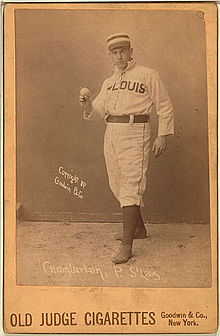
Elton P. "Ice Box" Chamberlain (November 5, 1867 – September 22, 1929) was an American professional baseball player. He played in the major leagues as a right-handed pitcher during 1886–1896. In several seasons, Chamberlain finished in his league's top ten in a number of pitching categories, including wins, earned run average, strikeouts, and shutouts. During one of his best seasons, the 1888 St. Louis Browns won the American Association pennant with a 92–43 record. Normally a right-handed pitcher, Chamberlain pitched the last two innings of an 1888 game with his left hand, making him a rare example of a switch pitcher.
Chamberlain finished his major-league baseball career with 264 complete games out of his 301 games started. After his playing days, he was hired as a baseball umpire and later announced he was becoming a boxer, but neither venture appears to have worked out. Not much is known about Chamberlain's later life. He died in Baltimore in 1929. (Full article...) -
Image 11
Ross Middlebrook "Pep" Youngs (April 10, 1897 – October 22, 1927) was an American professional baseball player. Nicknamed "Pep", he played ten seasons in Major League Baseball for the New York Giants from 1917 through 1926, playing right field almost exclusively. Youngs was a part of the Giants teams that won four consecutive National League pennants and the 1921 and 1922 World Series.
From Shiner, Texas, Youngs excelled at baseball and American football at the West Texas Military Institute. After beginning his professional career in minor league baseball, Youngs was signed by the Giants in 1916. Youngs had a lifetime .322 batting average with the Giants and batted over .300 nine times in his career, including eight consecutive seasons. His career was cut short by illness, however, as he died at the age of 30 of Bright's disease. (Full article...) -
Image 12
Ryan Francis Garko (born January 2, 1981) is an American former professional baseball outfielder, first baseman, and designated hitter. In college, he was a catcher. He played in Major League Baseball (MLB) for the Cleveland Indians, San Francisco Giants, and Texas Rangers, as well as in the KBO League for the Samsung Lions. Garko was seen by former ESPN reporter John Sickels as a good hitter who hit to all parts of the field, but with poor defensive instincts. He had a .275 batting average, 427 hits, 55 home runs, and 250 RBI in 463 career games.
When he attended Stanford University, Garko won the Johnny Bench Award and was named the Pac-10 Co-Player of the Year his senior year. He was also voted onto the College World Series Legends Team, featuring 28 of the best College World Series players as voted upon by fans, writers, and head coaches. During his time in the Cleveland Indians' organization, Garko was converted into a first baseman. In 2006, Baseball America ranked him as the fifth-best prospect in the Indians organization, including being the best at hitting for average. (Full article...) -
Image 13KUSI-TV (channel 51) is an independent television station in San Diego, California, United States. It is owned by Nexstar Media Group alongside Fox affiliate KSWB-TV (channel 69). KUSI-TV's studios are located on Viewridge Avenue (near I-15) in the Kearny Mesa section of San Diego, and its transmitter is located southeast of Spring Valley.
After a 15-year dispute over permit ownership that almost derailed the launch of the station on multiple occasions, KUSI began broadcasting in 1982 as a partnership between United States International University and McKinnon Broadcasting Company. It was the first independent station built in San Diego proper. Financial and accreditation problems at USIU led to the sale of its stake to McKinnon in 1990, with McKinnon exercising veto power to block any sale to another entity. McKinnon then started KUSI's news department, which has since grown to produce newscasts throughout the day. In 2023, McKinnon sold KUSI to Nexstar. The station's transmitter broadcasts KUSI and KSWB-TV in ATSC 3.0 (NextGen TV) format. (Full article...) -
Image 14
Alfred Stanley Benjamin (May 20, 1914 – December 24, 2009) was a right fielder in Major League Baseball for five seasons; four with the Philadelphia Phillies (1939–42), of the National League (NL), and one with the Cleveland Indians (1945), of the American League (AL). The 6 ft 2 in (1.88 m), 194 lb (88 kg) Benjamin batted and threw right-handed, and was born in Framingham, Massachusetts. After graduating from high school, he attended Western Maryland College, now known as McDaniel College, where he played baseball, basketball, and football.
In addition to his major league playing career, he played in minor league baseball for ten seasons. He began at the age of 23, with the Thomasville Orioles of the Georgia–Florida League in 1937, and finished as the player-manager for the Fresno Cardinals of the California League in 1948. During that time, he played in 955 minor league games, and batted .304, and hit 52 home runs. In the early 1940s, he was an assistant football coach at Northeastern University. Later, during his minor league career, he began coaching high school football, part-time, in his home town of Framingham, and then full-time once his playing and managing career ended. (Full article...) -
Image 15
Philip Joseph Hughes (born June 24, 1986) is an American former professional baseball pitcher. He played in Major League Baseball (MLB) for the New York Yankees, Minnesota Twins, and San Diego Padres during a career that spanned from 2007 through 2018. Hughes stands 6 feet 5 inches (1.96 m) tall and weighs 240 pounds (110 kg). He was the Yankees' first-round pick in the 2004 MLB draft.
During his time in the Yankees' minor-league system, Hughes became one of the most highly anticipated prospects in baseball. He debuted in the major leagues in 2007 as a starting pitcher and quickly demonstrated his potential with a bid for a no-hitter in only his second MLB start. However, injury cut short his outing, as well as significant portions of his 2007 and 2008 seasons. Hughes began 2009 in the minors but later returned to the majors, eventually becoming a relief pitcher in June and pitching as a setup man for Mariano Rivera. Hughes excelled in the new role during the regular season. Despite his struggles in the postseason, Hughes won a championship with the Yankees in the 2009 World Series over the Philadelphia Phillies. (Full article...)
Did you know (auto-generated) - load new batch

- ... that Dr. Twink Twining was a Major League Baseball player?
- ... that before Major League Baseball pitcher Keaton Winn was called up to the majors in June 2023, he had never been to a major league stadium?
- ... that before Sean Jackson won three Ivy League basketball championships, he won high school state championships in both baseball and basketball?
- ... that Margaret Donahue was the first female executive in Major League Baseball?
- ... that Larry Kennedy played professional baseball while serving as his town's mayor?
- ... that Corky Palmer coached the Southern Miss Golden Eagles to their only College World Series appearance in 2009?
- ... that Cy Block and Ross Horning testified before the United States Congress about how the reserve clause limited their careers in professional baseball?
- ... that Brewer Hicklen hosts an annual youth baseball camp in Alabama?
Quotes
| What we have are good gray ballplayers, playing a good gray game and reading the good gray Wall Street Journal. They have been brainwashed, dry-cleaned and dehydrated!...Wake up the echoes at the Hall of Fame and you will find that baseball's immortals were a rowdy and raucous group of men who would climb down off their plaques and go rampaging through Cooperstown, taking spoils....Deplore it if you will, but Grover Cleveland Alexander drunk was a better pitcher than Grover Cleveland Alexander sober.
— Bill Veeck, Chicago White Sox owner, on the contemporary disfavoring by Major League Baseball executives of players' acting boisterously off-field
|
 Featured lists - load new batch
Featured lists - load new batch
-
Image 1
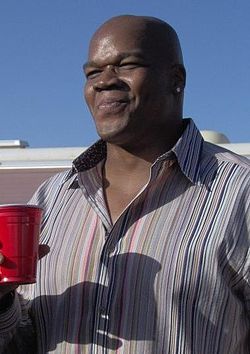
Frank Thomas (1989) was a two-time American League Most Valuable Player, and was a first-ballot Hall of Fame inductee in 2014.
The Chicago White Sox are a Major League Baseball (MLB) franchise based in Chicago, Illinois. They play in the American League Central division. Since the institution of MLB's Rule 4 Draft, the White Sox have selected 66 players in the first round. Officially known as the "First-Year Player Draft", the Rule 4 Draft is MLB's primary mechanism for assigning amateur baseball players from high schools, colleges, and other amateur baseball clubs to its teams. The draft order is determined based on the previous season's standings, with the team possessing the worst record receiving the first pick. In addition, teams which lost free agents in the previous off-season may be awarded compensatory or supplementary picks.
Of the 66 players picked in the first round by the Chicago White Sox, 32 have been pitchers, the most of any position; 20 of them were right-handed, while 12 were left-handed. Twelve outfielders, eight catchers, five shortstops, five third basemen, and four first basemen were also taken. The team has never drafted a player at second base. Fourteen of the players came from high schools or universities in the state of California, and Florida follows with eight players. The White Sox have also drafted six players from their home state of Illinois. (Full article...) -
Image 2

Mike Mussina (1990) made five all-star appearances with the Orioles.
The Baltimore Orioles are a Major League Baseball (MLB) franchise based in Baltimore, Maryland. They play in the American League East division. Since the institution of MLB's Rule 4 Draft, the Orioles have selected 60 players in the first round. Officially known as the "First-Year Player Draft", the Rule 4 Draft is MLB's primary mechanism for assigning amateur baseball players from high schools, colleges, and other amateur baseball clubs to its teams. The draft order is determined based on the previous season's standings, with the team possessing the worst record receiving the first pick. In addition, teams which lost free agents in the previous off-season may be awarded compensatory or supplementary picks.
Of the 60 players picked in the first round by Baltimore, 30 have been pitchers, the most of any position; 21 of them were right-handed, while 9 were left-handed. Twelve outfielders, eight shortstops, seven catchers, two third basemen, and one second basemen were also taken. The team has never drafted a player at first base. 16 of the players came from high schools or universities in the state of California, and Florida follows with five players. The Orioles have also drafted two players from Canada, Ntema Ndungidi (1997) and Adam Loewen (2002). The Orioles have not drafted any players from their home state of Maryland. (Full article...) -
Image 3

In 2019, Mike Trout signed a 12-year, $426 million contract with the Angels, the richest contract in the history of North American sports at the time.
Major League Baseball (MLB) does not have a hard salary cap, instead employing a luxury tax which applies to teams whose total payroll exceeds certain set thresholds for a given season. Free agency did not exist in MLB prior to the end of the reserve clause in the 1970s, allowing owners before that time to wholly dictate the terms of player negotiations and resulting in significantly lower salaries.
Babe Ruth, widely regarded as one of the greatest baseball players ever, earned an estimated $856,850 ($19,515,718 inflation-adjusted from 1934 dollars) over his entire playing career. When asked whether he thought he deserved to earn $80,000 a year ($1,459,124 inflation-adjusted), while the president, Herbert Hoover, had a $75,000 salary, Ruth famously remarked, "What the hell has Hoover got to do with it? Besides, I had a better year than he did." (Full article...) -
Image 4
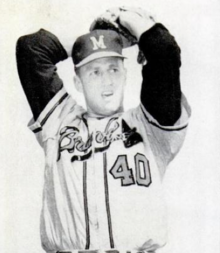
In baseball, a grand slam is a home run that is hit when the bases are loaded (i.e., there are runners occupying first, second, and third base simultaneously), thereby scoring four runs—the most possible in one play. Thirteen players have hit two grand slams in a single Major League Baseball (MLB) game to date, the most recent being Josh Willingham of the Washington Nationals on July 27, 2009. No player has accomplished the feat more than once in his career and no player has ever hit more than two in a game. Tony Lazzeri was the first player to hit two grand slams in a single game, doing so for the New York Yankees against the Philadelphia Athletics on May 24, 1936.
Every team which had a player hit two grand slams won their milestone games. These games have resulted in other single-game MLB records being set due to the prodigious offensive performance. Lazzeri, for example, proceeded to hit a third home run in the game and finished with a total of eleven runs batted in, an American League record. Fernando Tatís became the only player to hit two grand slams in the same inning, when he attained the milestone, slugging two in the third inning for the St. Louis Cardinals on April 23, 1999. In achieving the feat, he also set a new major league record with eight runs batted in in a single inning. (Full article...) -
Image 5

Roy Halladay is the only pitcher in Phillies history to throw multiple no-hit games with the team: a perfect game in May 2010; and a postseason no-hitter in October of that year.
The Philadelphia Phillies are a Major League Baseball franchise based in Philadelphia. They play in the National League East division. Also known in their early years as the "Philadelphia Quakers", pitchers for the Phillies have thrown fourteen separate no-hitters in franchise history. A no-hitter is officially recognized by Major League Baseball only "when a pitcher (or pitchers) allows no hits during the entire course of a game, which consists of at least nine innings", though one or more batters "may reach base via a walk, an error, a hit by pitch, a passed ball or wild pitch on strike three, or catcher's interference". No-hitters of less than nine complete innings were previously recognized by the league as official; however, several rule alterations in 1991 changed the rule to its current form.
Of the fourteen no-hitters pitched by Phillies players, three have been won by a score of 6–0, and three by a score of 1–0, more common than any other results. The largest margin of victory in a Phillies no-hitter was ten runs, in a 10–0 win by Chick Fraser. Charlie Ferguson's no-hitter, the first in franchise history, was a 1–0 victory, as were two of the more recent regular season no-hitters, thrown by Kevin Millwood in 2003 and Roy Halladay in 2010. Three pitchers to throw no-hitters for the Phillies have been left-handed: Johnny Lush (in 1906), Terry Mulholland (in 1990) and Cole Hamels (in 2015). The other nine pitchers were right-handed. Halladay is the only Phillies' pitcher to throw more than one no-hitter in a Phillies uniform, and others, including Hall of Famer Jim Bunning, have pitched more than one in their careers. The longest interval between Phillies no-hitters was between the games pitched by Lush and Bunning, encompassing 58 years, 1 month, and 20 days from May 1, 1906 to June 21, 1964. Conversely, the shortest interval between no-hitters was between Halladay's two 2010 no-hitters, with a total of merely four months and seven days from May 29 to October 6; the shortest gap between regular-season no-hitters was between Mulholland's and Tommy Greene's games (nine months and eight days from August 15, 1990 to May 23, 1991). Two opponents have been no-hit by the Phillies more than one time: the San Francisco Giants, who were defeated by Mulholland (in 1990) and Millwood (in 2003); and the Cincinnati Reds, who were no-hit by Rick Wise (in 1971) and Halladay (in 2010). (Full article...) -
Image 6

Todd Worrell (1982) is the only Cardinals first-round draft pick to win the Rookie of the Year Award.
The St. Louis Cardinals are a Major League Baseball (MLB) franchise based in St. Louis, Missouri. They play in the National League Central division. Since the institution of MLB's Rule 4 Draft, the Cardinals have selected 77 players in the first round. Officially known as the "First-Year Player Draft", the Rule 4 Draft is MLB's primary mechanism for assigning amateur baseball players from high schools, colleges, and other amateur baseball clubs to its teams. The draft order is determined based on the previous season's standings, with the team possessing the worst record receiving the first pick. In addition, teams which lost free agents in the previous off-season may be awarded compensatory or supplementary picks.
Of the 77 players picked in the first round by St. Louis, 39 have been pitchers, the most of any position; 30 of them were right-handed, while nine were left-handed. Eight outfielders, ten third basemen, six shortstops, six first basemen, five catchers, and two second basemen were taken as well. The team also drafted one player, Leron Lee (1966), who played as an infielder. 16 of the players came from high schools or universities in the state of California, and Texas and Arizona follow with seven and six players. The Cardinals have not drafted any players from their home state of Missouri. (Full article...) -
Image 7In its 124-year history, the Baltimore Orioles baseball franchise of Major League Baseball's American League has employed 42 managers. The duties of the team manager include team strategy and leadership on and off the field. Of those 42 managers, 12 have been "player-managers"; specifically, they managed the team while still being signed as a player. Since 1992, the team has played its home games at Oriole Park at Camden Yards.
The Baltimore franchise began operations in Milwaukee, Wisconsin, as the Brewers (not to be confused with the current National League team of the same name) in 1901. After one season in Wisconsin under manager and Hall of Famer Hugh Duffy, the franchise moved south to St. Louis, Missouri, adopting the St. Louis Browns name and hiring a new manager, Jimmy McAleer. The Browns remained in Missouri until the end of the 1953 season, when Major League Baseball's owners elected to move the franchise to Baltimore, Maryland, where they were renamed the Orioles, after Maryland's state bird. (Full article...) -
Image 8

Mike Piazza is the all-time leader in Silver Slugger Awards among catchers, winning ten consecutive from 1993 to 2002.
The Silver Slugger Award is awarded annually to the best offensive player at each position in both the American League (AL) and the National League (NL), as determined by the coaches and managers of Major League Baseball (MLB). These voters consider several offensive categories in selecting the winners, including batting average, slugging percentage, and on-base percentage (OBP), in addition to "coaches' and managers' general impressions of a player's overall offensive value." Managers and coaches are not permitted to vote for players on their own team. The Silver Slugger was first awarded in 1980 and is given by Hillerich & Bradsby, the manufacturer of Louisville Slugger bats. The award is a bat-shaped trophy, 3feet (91cm) tall, engraved with the names of each of the winners from the league and plated with sterling silver.
Among catchers, Mike Piazza has won the most Silver Slugger Awards, with ten consecutive wins in the National League between 1993 and 2002; this is the most Silver Sluggers won consecutively by any player in Major League Baseball. In the American League, Iván Rodríguez has won the most Silver Sluggers, with six consecutive wins from 1994 to 1999, and a seventh when he tied with Víctor Martínez in 2004. Lance Parrish won the American League award six times (1980, 1982–1984, 1986, and 1990), and Joe Mauer, Jorge Posada and Salvador Pérez have won it five times; Mauer won in 2006, 2008–2010 and 2013, Posada won in 2000–2003 and 2007, and Pérez won it in 2016, 2018, 2020, 2021 and 2024. Hall of Famer Gary Carter (1981–1983, 1984–1986), Buster Posey (2012, 2014–2015, 2017, 2021), and Brian McCann (2006, 2008–2011) are five-time winners in the National League; McCann also won a sixth Silver Slugger in 2016, but in the American League. Other multiple awardees include Benito Santiago (four wins; 1987–1988, 1990–1991), J. T. Realmuto (three wins; 2018–2019, 2022), Mickey Tettleton (three wins; 1989, 1991–1992) and Carlton Fisk (three wins; 1981, 1985, 1988). William Contreras and Salvador Pérez are the most recent National and American League winners, respectively. (Full article...) -
Image 9

Frank Bancroft managed the Worcester team in 1879 and 1880.
The Worcester Worcesters, sometimes referred to as the Brown Stockings or the Ruby Legs, were a Major League Baseball team based in Worcester, Massachusetts. Though the team's alternate names appear in many modern sources, no contemporary records from the time exist that support the use of names other than "Worcester". They existed in the National League (NL) from 1880 to 1882, and played their home games at the Worcester Agricultural Fairgrounds.
The team was organized in 1879 as the Worcester Baseball Association, and joined the minor league National Association. The team was profitable, successful against rival teams, and did well against NL teams in exhibition games. After the season, team management turned their attention on the NL, and pursued the slot vacated by the departing Syracuse Stars. The team was voted into the NL by a majority of the owners, and in 1880, the team began their first season. The manager of the team, Frank Bancroft, and many of the players stayed with the team when it joined the NL, including pitchers Lee Richmond and Tricky Nichols, and position players Arthur Irwin, Doc Bushong, Charlie Bennett, and Chub Sullivan. On June 12, Richmond threw the first perfect game in major league history, against the Cleveland Blues. Harry Stovey, in his first major league season, led the league in triples and home runs. However, the Ruby Legs were, in turn, no-hit on August 20 by Pud Galvin of the Buffalo Bisons, becoming the first team to be no-hit at home. They played 85 games in their first season, and had a win–loss record of 40 wins, 43 losses, with 2 ties, finishing fifth in the league. (Full article...) -
Image 10

The New York Yankees are a Major League Baseball (MLB) franchise based in The Bronx, New York City, New York. They play in the American League East division. This list consists of the owners, general managers (GMs) and other executives of the Yankees. The GM controls player transactions, hires the manager and coaching staff, and negotiates with players and agents regarding contracts.
The longest-tenured general manager in team history is Brian Cashman, who serves in that role for 26 years and counting. The longest-tenured owner in team history is George Steinbrenner, who was the team's principal owner from 1973 until his death in 2010. (Full article...) -
Image 11
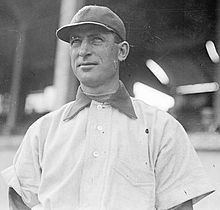
Hall of Famer Fred Clarke was the Louisville Colonels' last Major League manager.
The Louisville Colonels were a Major League Baseball team that played in Louisville, Kentucky. They played in the American Association when it was considered a major league from 1882 through 1891 and in the National League from 1892 through 1899, after which the team folded and its best players were transferred to the Pittsburgh Pirates. From 1882 through 1884 the team was named the Louisville Eclipse. During their time as a Major League team, the Colonels employed 17 managers. The duties of the team manager include team strategy and leadership on and off the field.
The Colonels' first manager was Denny Mack. Mack managed the team for one season (1882), in which he led the Colonels to a record of 38 wins and 42 losses. Fred Clarke was the Colonels' last manager. Clarke took over as player-manager of the team during the 1897 season, and managed the team through the 1899 season while also playing as an outfielder for the Colonels. Clarke was one of the players transferred to the Pittsburgh Pirates in 1900, as were Honus Wagner, Tommy Leach, Claude Ritchey and Deacon Phillippe. Clarke took over as the Pirates' player-manager, and after a second-place finish in 1900, he led the Pirates, with the former Colonels stars, to three consecutive league pennants in 1901, 1902, 1903, and a World Series championship in 1909. Clarke was inducted into the Baseball Hall of Fame in 1945, the only Colonels' manager so honored. The Colonels won their only Major League pennant when they had the best record in the American Association in 1890. They played to a tie in the World Series that season against the National League champion Brooklyn Bridegrooms; each team won three games and there was one tie game.[a] Jack Chapman was the Colonels' manager that season. (Full article...) -
Image 12The Roberto Clemente Award is given annually to the Major League Baseball (MLB) player who "best exemplifies the game of baseball, sportsmanship, community involvement and the individual's contribution to his team", as voted on by baseball fans and members of the media. It is named for Hall of Fame outfielder Roberto Clemente. Originally known as the Commissioner's Award, it has been presented by MLB since 1971. In 1973, the award was renamed after Clemente following his death in a plane crash while he was delivering supplies to victims of the Nicaragua earthquake.
Each year, a panel of baseball dignitaries selects one player from among 30 nominees, one from each club. Teams choose their nominee during the regular season, and the winner is announced before Game 3 of the World Series. The player who receives the most votes online via MLB's official website, MLB.com, gets one vote in addition to the votes cast by the panel. Since 2007, the Roberto Clemente Award has been presented by Chevy. Chevy donates money and a Chevy vehicle to the recipient's charity of choice and additional money is donated by Chevy to the Roberto Clemente Sports City, a non-profit organization in Carolina, Puerto Rico, that provides national sports activities for children. Chevy donates additional funds to the charity of choice of each of the 30 club nominees. (Full article...) -
Image 13

Craig Biggio (1987) is the only first-round draft pick of the Astros with over 3000 career hits.
The Houston Astros, originally called the "Colt .45s", are a Major League Baseball (MLB) franchise based in Houston, Texas. They play in the American League West division. Since the institution of Major League Baseball's Rule 4 Draft, the Astros have selected 57 players in the first round. Officially known as the "First-Year Player Draft", the Rule 4 Draft is Major League Baseball's primary mechanism for assigning amateur baseball players from high schools, colleges, and other amateur baseball clubs to its franchises. The draft order is determined based on the previous season's standings, and the team that had the worst record receives the first pick. In addition, teams which lost free agents in the previous off-season may be awarded compensatory or supplementary picks. The First-Year Player Draft is unrelated to the 1961 expansion draft in which the Astros initially filled their roster.
Of the 57 players picked in the first round by Houston, 24 have been pitchers, the most of any position; 21 of these were right-handed, while 3 were left-handed. Ten catchers were selected, while nine outfielders, nine shortstops, two first basemen, and two third basemen were taken as well. The team also selected one player at second base. Thirteen of the players came from high schools or universities in the state of California, while Texas and Tennessee follow with five and three players, respectively. They have also drafted two players from outside the United States: Carlos Correa (2012) and Ramón Castro (1994), both from Puerto Rico. (Full article...) -
Image 14

Mike Schmidt is the Phillies all-time leader in home runs and RBIs
The Philadelphia Phillies have participated in 140 seasons in Major League Baseball since their inception in 1883. They are the oldest continuous same-name, same-city franchise in all of American professional sports. Through October 1, 2022, they have played 21,203 games, winning 10,019 games and losing 11,184.
Since their 1883 inception, the team has made 14 playoff appearances, won eight National League pennants, and won two World Series championships (against the Kansas City Royals in 1980 and the Tampa Bay Rays in 2008). (Full article...) -
Image 15The New York Mets are a professional Major League Baseball (MLB) franchise based in New York City, New York in the borough of Queens. They play in the National League East division. In the history of the Mets, there have been 23 managers that managed a game including four interim managers. Of those managers, only Joe Torre was a player-manager (a manager who also plays for the team); Yogi Berra did play four games while he was a coach for the Mets in 1965. Gil Hodges, Roy McMillan, Bud Harrelson, Mike Cubbage, Dallas Green, Bobby Valentine and Willie Randolph all also played in MLB for the Mets prior to becoming the team's manager.
The Mets posted their franchise record for losses in their inaugural season in the league, with 120 losses in 160 games in 1962. This was the first of seven consecutive losing seasons, a season in which the winning percentage was below .500, and the most losses by a post-1900 MLB team. During this stretch from 1962 to 1968, the Mets employed four managers. Seven managers have taken the Mets to the postseason; Davey Johnson, Bobby Valentine and Terry Collins have led the team to two playoff appearances each. Johnson and Gil Hodges are the only Mets managers to win a World Series: Hodges in 1969 against the Baltimore Orioles; and Johnson in 1986 against the Boston Red Sox. Terry Collins is the longest-tenured manager in franchise history, with 1,134 games of service over 7 seasons. (Full article...)
More did you know
- ... that the San Francisco Giants drafted Brock Bond when they meant to draft Casey Bond?
- ... that Eddie Gillette led the Wisconsin Badgers football team to an undefeated season and in baseball "beat some of the best pitchers in the 'Three-Eye League'"?
- ... that the 2005 book Baseball Before We Knew It brought new evidence of the origins of baseball into play?
- ... that in baseball, no Gold Glove Award-winning catcher posted an errorless season until Charles Johnson and Mike Matheny accomplished the feat twice in six years?
- ... that Bob "Horse" Reynolds founded the Los Angeles Angels baseball team and was inducted into the College Football Hall of Fame within a year?
- ... that Red Snapp was considered the "king of the minor leagues"?
Sports portals
Selected picture
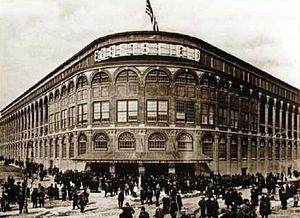
| Credit: Unknown |
Ebbets Field was a Major League Baseball park located in the Flatbush section of Brooklyn, New York. It was the home of the Brooklyn Dodgers of the National League. Two different incarnations of a Brooklyn Dodgers football team also played at the stadium. The park opened on April 9, 1913, and was demolished in 1960, three years after the team relocated to Los Angeles.
Associated Wikimedia
The following Wikimedia Foundation sister projects provide more on this subject:
-
Commons
Free media repository -
Wikibooks
Free textbooks and manuals -
Wikidata
Free knowledge base -
Wikinews
Free-content news -
Wikiquote
Collection of quotations -
Wikisource
Free-content library -
Wikiversity
Free learning tools -
Wiktionary
Dictionary and thesaurus
More portals
- Portals with triaged subpages from June 2018
- All portals with triaged subpages
- Portals with no named maintainer
- Automated article-slideshow portals with 51–100 articles in article list
- Automated article-slideshow portals with 501–1000 articles in article list
- Random portal component with 41–50 available subpages
- Automated article-slideshow portals with 201–500 articles in article list
- Random portal component with 11–15 available subpages
- Random portal component with 21–25 available image subpages

